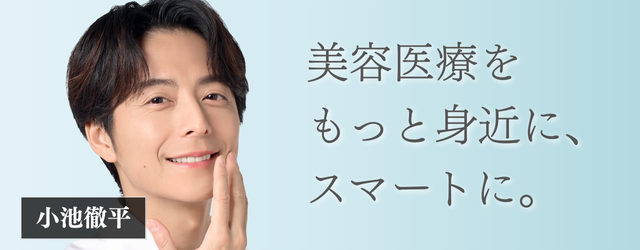Doctor's Explanation] Which is the quickest way to improve facial sagging in one's 50s?
'Sagging under the eyes, cheeks, chin, and face make me look older.'
I used to be so much sleeker... I wonder if there's anything I can do about these facial lines..."
I wonder if there's a better way to get rid of the sagging."
Are you in your 40s or 50s and have you given up on the idea that it's inevitable that your face will sag with age, that it's just the way it is?
Indeed, as people age, the number of cells that build up the body decreases and their functions deteriorate, causing the skin to lose its elasticity and sag.
However, this does not mean that there are no ways to improve it.
In this article, I, as a cosmetic dermatologist, will explain three ways to improve facial sagging in your 50s from a professional and easy-to-understand perspective.
Please read on.
Chairman of Smart Skin Clinic Group
stone Kouta
career
Graduated from Juntendo University School of Medicine
Tokyo Women's Medical University Hospital and related facilities
Worked at a major beauty clinic in Tokyo
Affiliation / Qualifications
Japan Surgical Society Specialist
Japanese Society of Anti-Aging Medicine
What are the three options to improve sagging?
There are three major approaches to improving facial sagging.
- Self-care:Slowly and cost-effectively.
Massage, facial muscle training, acupressure, stretching, etc. - Non-surgical cosmetic procedures:Natural rejuvenation from the inside out
Injection-based" and "laser-based." - Firm beauty treatment:Immediate and lasting physical lifting
Thread lift, liposuction, facelift.
The three options are summarized in the table below. We hope it gives you an overview.
| (1) Self-care | (2) Cosmetic procedures that do not require cutting | (3) Firm beauty treatment | |
| massage Facial Muscle Training etc. | injection system Laser System | riffling with a thread (i.e. picking up ruffles on a string, etc.)7th note in the diatonic scale (used in key names, etc.)liposuction facelift | |
| Mechanism of Effect | indirect Aimed at improving blood flow, relaxing and tightening muscles, and lifting with the effect of removing waste products. | indirect Aiming to increase tissue growth that controls skin elasticity and firmness, and to tighten stretched fascia to lift up the skin. | direct Physical removal of sagging skin, including lifting of sagging skin and removal of enlarged fat inside the sagging skin |
| Effectiveness. Duration | Temporary and very short term | Effects begin to appear a few weeks to 2 months after treatment and last 6 months to 2 years | Immediately after downtime ~ several years |
| cost (Price) | 'good work' (equiv. of silver star awarded to children at school) nashi (Pyrus pyrifolia, esp. var. culta) | period 60,000-150,000 yen/times | weak 100,000-500,000 yen |
| risk after-effect important point | Not doing it the right way can contribute to further sagging | Limited duration of effect, so continuous treatment is required to maintain the effect. | There is always downtime. Risk of complications (swelling, internal bleeding, infection, parotid duct injury, facial nerve injury, etc., although rare) |
| Advantages | Can be done at home without cost. Easy to adopt as a daily habit | Relatively safe because it is not surgery Short or no downtime required | Can physically eliminate sagging. Relatively long treatment effects can be obtained with a single treatment. |
| Demerit | Limited effectiveness and less immediate effect. Requires continuous effort If done incorrectly, it can contribute to sagging. | Limited duration Need to continue. Cost will be high in the long run. Effects vary from person to person. | High cost There is downtime, there are risks associated with the surgery, and there may be surgical scars. |
| feature | Effective only for prevention of sagging or mild sagging Easy to get started | Effective for moderate sagging No immediate effect is expected. Natural skin rejuvenation and texture enhancement | Effective for severe sagging Immediate and lasting Results depend on the skill of the practitioner. |
Four causes of sagging
Sagging is a physical change that occurs with aging and is caused by a combination of internal factors (hormonal balance and muscle deterioration), external factors (UV rays and dryness), and lifestyle factors (diet, lack of sleep, smoking).
Due to the above effects, sagging medically occurs when the following four things happen
- Decrease in collagen, elastin, and hyaluronic acid
- Fat bloat
- Muscle atrophy/decline
- bone atrophy
Decrease in collagen, elastin, and hyaluronic acid
The skin consists of three major layers: epidermis, dermis, and subcutaneous tissue.
The dermis layer is involved in sagging, and the dermis layer is responsible for maintaining skin firmness and elasticity.
[How the dermis works
The dermis is dominated by two fibers: collagen and elastin. Collagen acts like a spring and elastin acts like rubber, binding the collagen together so that it does not fall apart. These fibers keep the skin flexible and strong.
The space between these fibers is then filled with a jelly-like substance such as hyaluronic acid.
Fibroblasts are responsible for the production of collagen, elastin, hyaluronic acid, and other components of the dermis.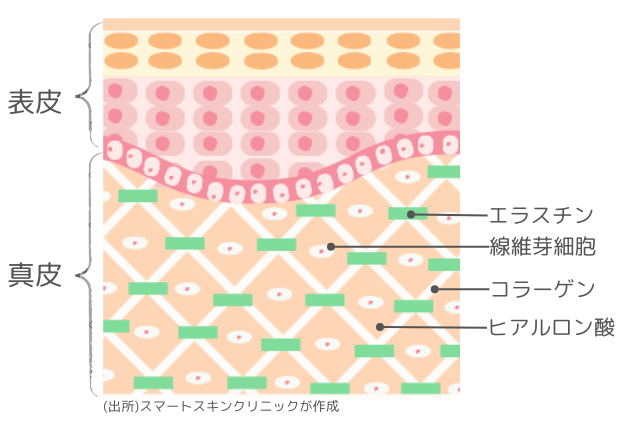
The decrease in collagen, elastin, and hyaluronic acid is a natural biological process associated with aging.
There are two reasons for this. One is that collagen and elastin break down due to the accumulated effects of UV rays, oxidation, and glycation. The other reason is that the number of fibroblasts decreases with age and their function declines, making it impossible to produce new collagen, elastin, and hyaluronic acid.
Fat bloat
Fat hypertrophy is a phenomenon in which fat cells become larger and their volume increases.
Metabolic changes associated with aging and fluctuations in hormonal balance are related. In women in particular, a decrease in female hormones is said to affect the distribution of fat cells.
As the size of fat cells increases, their weight pulls them downward, resulting in sagging of the face.
Fat hypertrophy is especially common in the lower cheeks, jawline, or under-eye area.
Muscle atrophy/decline
There are several reasons for muscle atrophy or loss. These include changes in metabolic processes due to aging, decreased activity, and hormonal imbalances.
Weakening of facial muscles, especially the facial expression muscles, reduces the ability to support the skin. Insufficient muscle support changes the tension and position of the skin, causing the face to sag.
bone atrophy
There are several causes of bone atrophy. It can be caused by decreased activity of bone-forming cells, increased bone resorption, or nutritional deficiencies.
These causes decrease bone density and thinning of the bones. Bone atrophy can also be described as a natural process of aging.
As the facial skeleton atrophies, there is excess skin covering it. Skin tension is lost and appears as sagging.
Three options to improve sagging
Option 1) Self-care
The first option would be self-care.
Although we will not be presenting specific methods in this article, we have summarized how self-care can be effective.
Self-care includes "massage," "facial muscle training," "acupressure," and "stretching.
There are a variety of techniques, but these self-care practices,
0Improve blood circulation → Promote lymphatic flow → Promote waste discharge → Improve swelling and swelling
0Improved blood circulation → Nutrients and blood flow to skin tissues → Accelerated metabolism and cell renewal
0 relaxes muscles and relieves tension → reduces wrinkle formation and improves skin flexibility
Strengthens the 0 muscle → Increases the ability to pull the skin up.
This is the process of improving sagging with this type of effect.
Self-care can be easily started without cost as an advantage. It is effective for mild sagging or for the purpose of preventing sagging, when it can be incorporated as part of a daily lifestyle.
However, the disadvantages are that the effect is limited and less immediate, and the effect cannot be sustained unless it is continued.
Severe sagging, inability to sustain self-care, or expecting immediate results.
Caution! Massage can be counterproductive if not done correctly!
In addition, there is a caution in self-care face massage. The opposite is that it can promote sagging.
Face massage has some positive effects (improved blood flow, muscle relaxation and tightening) as just described. However, there are some who question its effectiveness from a medical point of view.
There are three reasons for this: excessive pressure, skin friction, and incorrect lymphatic fluid flow.
Massage performed with too much pressure or improper technique can pull too much skin. Friction also places stress on the skin. This friction can cause irritation and damage to the skin, leading to sagging.
Otherwise, if lymphatic fluid cannot flow in the correct direction, the flow can be reversed, causing swelling and sagging.
When performing face massage, it is important to learn the correct technique and to keep proper pressure in mind.
Option 2: Cosmetic procedures that do not involve cutting
The next option is a non-invasive cosmetic procedure using injections or lasers.
0Injection system: Profilo
0Injection system: Jalpro Super Hydro
0Laser system: HIFU
Although it is a cosmetic procedure, there are relatively few risks and disadvantages such as side effects, aftereffects, and downtime.
All three treatments take at least several weeks to show results.
The effect varies from person to person, and the duration of the effect is not permanent. Therefore, it is difficult to say that there is an immediate effect, and the treatment must be repeated regularly in order to continue to obtain the desired effect.
However, it can provide natural firmness and lifting from the inside out and a rejuvenating effect on the skin's texture. The reason for this is that it works directly on collagen/elastin and the muscle layer.
I want to improve my sagging, but I don't want people to know that I've done something.
This will be the most recommended method for those who think this way.
Injectable system: Profilo
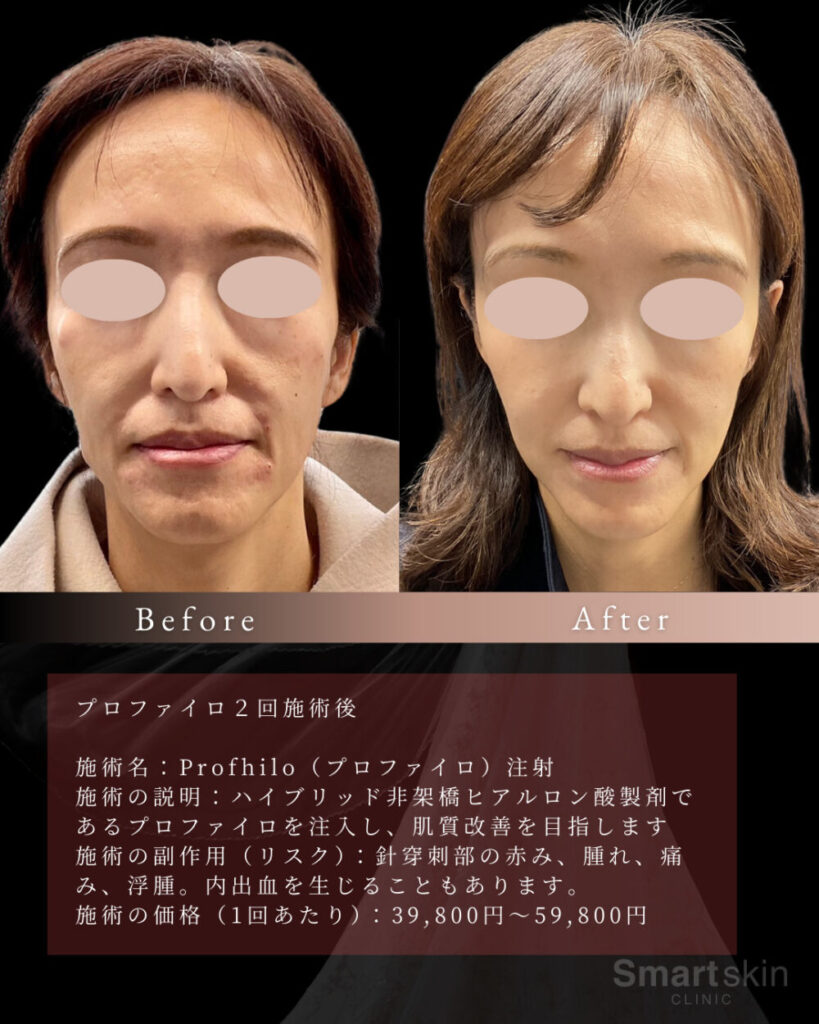
Profibro is a cosmetic procedure in which a high concentration of hyaluronic acid is injected into the skin.
Profibro is one of the non-cross-linked hyaluronic acids called next-generation hyaluronic acids, which have attracted attention in recent years as "ECM remodeling therapy.
What is ECM remodeling therapy?
First, ECM is an acronym for ExtraCellularMatrix. Translated as extracellular matrix, it refers to the outer part of the fibroblast. Specifically, it is the fibrous tissue and matrix portion, such as collagen, elastin, and hyaluronic acid, that surrounds fibroblasts.
Second, remodeling means to rebuild. In other words,ECM remodeling is the filling of gaps around fibroblasts with increased scaffolding such as collagen and elastin and hyaluronic acid. In other words, it rebuilds the diminished dermis.This means.
Injecting non-cross-linked hyaluronic acid injections can fill the substrate with hyaluronic acid and at the same time stimulate the fibroblasts. This stimulation causes the fibroblasts to produce collagen and elastin.
ECM remodeling treatment does not cause unnatural changes. The reason for this is due to the body's own inherent resilience. The changes are gradual over time and lack immediate results.
The Profibro procedure involves injections into 10 defined areas of the face (5 on each side). Immediately after injection, there will be an insect bite-like swelling, which will be absorbed and become less noticeable in a few hours.
To learn more about Profilo, please see this article.
If you would also like to receive a profilo, please make an appointment below.
Injection system: Jalpro Super Hydro
JalPro Super Hydro is another type of non-cross-linked hyaluronic acid, which is an injectable formulation used for ECM remodeling treatment.
A detailed explanation of ECM remodeling is provided in the earlier Profilo page, so if you have not yet read it, please do so and take a look.
It is a non-cross-linked hyaluronic acid preparation, the same as Profibro, but differs in three ways.
They are "the difference in composition," "ligament regeneration," and "the method of injection."
Differences in Ingredients."
JalPro Super Hydro contains amino acids and peptides in addition to hyaluronic acid (Profibro is pure hyaluronic acid only)
The amino acids and peptides it contains function as nourishment for skin cells and may further promote skin regeneration.
Ligament Reclamation."
What is ligament?
Ligaments are fibrous tissues that hold bone and skin (or nearby structures) firmly together and are support ligaments.Ligaments are composed primarily of collagen fibers, and these fibers are produced by fibroblasts.
In the face, ligaments are particularly important, acting as vertical fibrous tissue that supports soft tissues such as the skin and SMAS layer from moving too far away from the bone, thus maintaining the stability of the facial structure.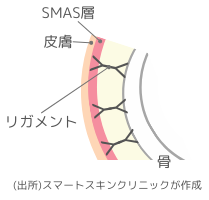
Ligament regeneration is related to the fact that ligaments are produced by fibroblasts.
As explained earlier in the "Ingredient Differences" section, the amino acids and peptides in JalPro Super Hydro are believed to activate skin cells and promote collagen and elastin production. Since ligament is composed primarily of collagen, it is believed that ligament regeneration is enhanced.
Injection Methods."
JalPro Super Hydro is often injected in a more customized manner than Profibro. Skin depth and injection volume are adjusted according to the area to be treated and the skin condition.
The appearance and progress after injection can be described as similar to that of Profibro, but with regard to the time of onset of effects, the additional ingredients (especially amino acids) contained in JalPro may make a difference in its effect on skin repair and regeneration.
To learn more about Jal Pro Super Hydro, please see this article.
If you are also interested in taking Jal Pro Super Hydro, please make an appointment below.
Laser-based: HIFU
HIFU is an acronym for High Intensity Focused Ultrasound.
The high-density ultrasound energy becomes thermal energy and is delivered to specific depths in the skin tissue.
The inner skin is layered in the following order: skin (epidermis and dermis), subcutaneous tissue (mainly fatty tissue), SMAS layer, muscle, and bone. HIFU is mainly irradiated to the dermis, subcutaneous tissue, and SMAS layer to exert its effect.
What is the SMAS layer?
SMAS (Superficial Muscular Aponeurotic System) is also called superficial fascia. It is different from muscles such as the so-called facial muscles. Facial muscles control facial movements and expressions,The SMAS layer is a layer of tough connective tissue covering these musclesIt is classified as a
The SMAS layer acts as an intermediate layer between the skin and the facial muscles and is closely related to and often moves with the skin. It plays an important role in face lifting.
The effect exerted by HIFU heat energy depends on where it is delivered.
When irradiated to the dermis, it stimulates fibroblasts, promoting collagen and elastin production → reconstruction of fiber tissue.
When irradiated to subcutaneous tissue, the thermal energy can cause melting or destruction of fat.
If the SMAS layer is irradiated, the stretched collagen and elastin will be contracted and the SMAS layer will be tightened. When heat is applied to raw meat, the meat shrinks, right? It is the same principle.
This effect of improving skin firmness and elasticity leads to the elimination of sagging.
HIFU is widely used in the cosmetic dermatology field as a treatment for sagging skin. The reason for this is that one of the greatest advantages of HIFU is that it provides a lifting and tightening effect without the use of a scalpel. However, the disadvantages are that the treatment effect varies greatly from person to person and, although very infrequent, complications such as burns and nerve palsy may occur in very rare cases.
Option 3) Firm cosmetic treatment
The last three cosmetic procedures will be invasive.
Thread lift
0Liposuction
0Facelift
Although the approaches are different, all three procedures have immediate results in terms of eliminating the appearance of sagging.
I'm willing to spend the money, but I just want to get rid of the sagging right away."
This will be the method of choice for those who
However, there is one thing that must be carefully considered well before making a choice. That is, you must find a good practitioner (clinic) because the effectiveness of the treatment depends on the skill of the practitioner. The risk of downtime and complications must be fully considered. Another point is that for those who are looking to reduce high costs, the different menus and fee structures at different clinics can make the choice of a clinic even more difficult.
Thread lift
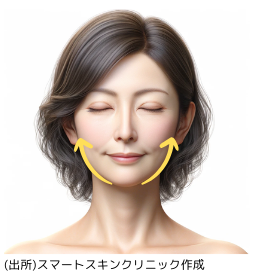
Thread lift is a treatment that uses special threads (threads) to physically lift sagging areas.
Thread lift has two lifting effects. One is the direct lifting effect of the threads. The other is an indirect effect, in which the inserted threads stimulate the skin to improve metabolism and increase collagen and elastin production.
The threads used are the same material used in surgery and are naturally degraded and absorbed by the body. It takes 6 to 24 months for the threads to break down, during which time the lifting effect lasts.
This treatment is performed under local anesthesia and is a day treatment. Because it does not involve incisions, downtime is relatively short, and patients can often return to their daily activities immediately after the procedure.
It is considered to have relatively few sequelae, but there are rare cases of difficulty moving the mouth and exposure of the threads.
liposuction
Liposuction is an invasive cosmetic procedure that suctions excess fat from the face. It removes excess fat that causes sagging and improves facial contours.
Some liposuction procedures are designed to reduce fat in the entire face, while other techniques have a limited target area that focuses on a specific area of the face, such as bacal fat, meller fat, and george fat removal.
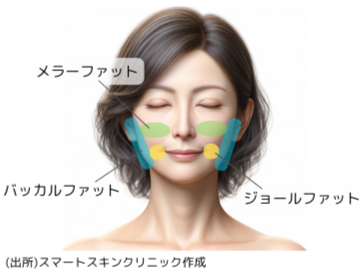
If sagging skin remains after aspiration, it may be combined with a thread lift at the same time.
The physician will determine the appropriate method of liposuction based on individual needs and conditions. It is very important to be able to find a doctor you can trust, as it depends largely on the skill of the physician.
What I am going to introduce here is a general method. We hope you can imagine it as one of the methods.
Liposuction is generally performed under local anesthesia. For liposuction of the cheeks and chin, a small incision is made at the base of the ear, through which a thin tube is inserted, and manual liposuction using a syringe (syringe) is generally chosen. This is usually done on a day trip basis.
In liposuction surgery, symptoms of internal bleeding and swelling usually appear for about two weeks after surgery.
facelift
A facelift is a surgical procedure to lift sagging skin and remove excess skin.
It is suitable for people with significant facial sagging and is expected to have a long-term rejuvenating effect.
On the other hand, it is the most invasive of the three procedures, and the risks of complications and downtime must be fully considered.
Facelifts can be divided into two main categories: "large-scale procedures that aim to lift the entire face," known as SMAS or ligament procedures, and "small-scale procedures that aim to improve a limited area," known as mini-lifts.
When the area to be lifted is extensive, as in a full face lift, the ligaments may prevent the skin from being lifted sufficiently. In such cases, a technique called the ligament technique is used, in which the ligament is cut off and re-fixed together with the lifted skin. However, manipulation of the ligament area means that the manipulation extends deep under the SMAS, which increases the risk of nerve damage.
For facelifts, general anesthesia and hospitalization are determined by the patient's condition and the extent of the surgery.
The most recommended way to improve sagging for people in their 50s
The most recommended method of improving sagging skin for people in their 50s is a non-surgical cosmetic procedure.
The main reason why we recommend it is because the benefits obtained are large for little risk.
Again, injectable procedures and laser-based HIFU, which are cosmetic procedures that do not involve cutting, can effectively address the decrease in collagen and elastin that causes sagging.
Because these procedures are non-invasive, there is relatively little downtime and risk. They are also less dependent on the skill of the practitioner, which reduces anxiety when selecting a clinic.
For people in their 50s, improving sagging skin is a step toward regaining confidence and vitality as well as appearance. By choosing a safe and effective treatment that is right for you, you will be able to live a more radiant life.
For non-surgical cosmetic procedures, go to Smart Skin Clinic.
Smart Skin Clinic is a cosmetic dermatology clinic and specializes in "cosmetic procedures without cutting" and "natural changes".
Especially in the "injection-type" treatment, which requires great technical skill, we are committed to the following
If you are suffering from "sagging," please feel free to come to Smart Skin Clinic for a consultation.


